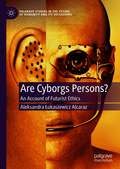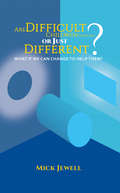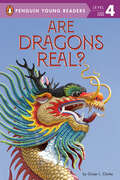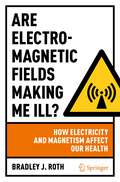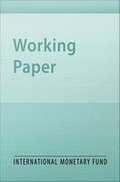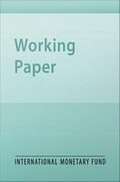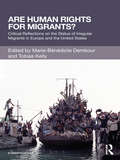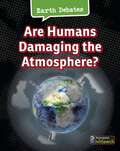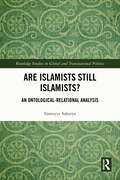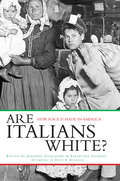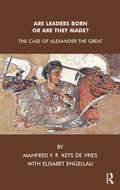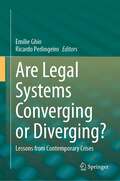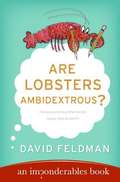- Table View
- List View
Are Currency Crises Predictable?1
by Ilan Goldfajn Rodrigo O. ValdésA report from the International Monetary Fund.
Are Cyborgs Persons?: An Account of Futurist Ethics (Palgrave Studies in the Future of Humanity and its Successors)
by Aleksandra Łukaszewicz AlcarazThis book presents argumentation for an evolutionary continuity between human persons and cyborg persons, based on the thought of Joseph Margolis. Relying on concepts of cultural realism and post-Darwinism, Aleksandra Łukaszewicz Alcaraz redefines the notion of the person, rather than a human, and discusses the various issues of human body enhancement and online implants transforming modes of perception, cognition, and communication. She argues that new kinds of embodiment should not make acquiring the status of the person impossible, and different kinds of embodiments may be accepted socially and culturally. She proposes we consider ethical problems of agency and responsibility, critically approaching vitalist posthuman ethics, and rethinking the metaphysical standing of normativity, to create space for possible cyborgean ethics that may be executed in an Extended Republic of Humanity.
Are Developing Countries Better Off Spending Their Oil Wealth Upfront?
by Kenichi Ueda Hajime Takizawa Edward H. GardnerA report from the International Monetary Fund.
Are Diamonds Forever? Using the Permanent Income Hypothesis to Analyze Botswana's Reliance on Diamond Revenue
by Olivier BasdevantA report from the International Monetary Fund.
Are Difficult Children Difficult, or Just Different? What if We Can Change to Help Them?
by Mick JewellAs an adult working with, or caring for, 'difficult' children, how can you change your approach to suit the differing learning and progression needs necessary to advance the children? Are Difficult Children Difficult, or Just Different? What if We Can Change to Help Them? is aimed at teachers, social workers, foster carers, adoptive parents, birth parents, medical professionals and any adult involved with young people who do not present in line with the majority of expected behaviours and traits regularly seen in children aged between 5 and 16 years old. This problem is growing and we need to adapt. Tried and tested strategies and real-life examples are described in detail to help you alter your approach, in lieu of attempting to change the brain pattern of the 'difficult child'. Bringing them in line with more traditional methods that quite simply do not, will not and cannot work in the long term is not an option. It is a refreshing and positive approach that you will enjoy whilst you build and share improved strategies for dealing with and helping young people 'outside the norm' of traditional teaching and parenting styles.
Are Donor Countries Giving More or Less Aid?
by Sanjeev Gupta Catherine Pattillo Smita WaghA report from the International Monetary Fund.
Are Dragons Real? (Penguin Young Readers, Level 4)
by Ginjer L. ClarkeLearn about the history of dragons in this photographic nonfiction leveled reader perfect for kids interested in the natural - and unnatural - world!Did you know that Marco Polo, Alexander the Great, and other explorers all described seeing dragons in their ancient travels? Or that the Komodo dragon may not breathe fire, but it has a venomous bite to help catch its prey? Even today there are still some types of dragons roaming the earth!Embracing children's delight in the mythical creatures while also imparting fascinating facts about the real ones, discover the history of these special animals and decide for yourself if you believe in dragons!With simple language and vivid photographs, Are Dragons Real? is perfect for emerging readers curious about the natural world and this legendary creature.
Are Electromagnetic Fields Making Me Ill?: How Electricity and Magnetism Affect Our Health
by Bradley J. RothElectricity and Magnetism (E&M) underlies many lifesaving medical devices, such as magnetic resonance imaging scanners, neural stimulators, and heart pacemakers. But E&M also attracts its share of bogus health claims, such as biomagnetic therapy. How do you separate the good from the bad? Sometimes it’s not easy: experiments are prone to artifacts, theories are limited by assumptions, and clinical trials can result in ambiguities. In this book, the author separates the wheat from the chaff, showing which applications of E&M are bogus and which are not. This book takes the reader on a tour through a range of fascinating phenomena, from effects that are constant in time at one extreme, such as transcranial direct current stimulation of the brain, to the millimeter-wave whole-body scanners which are familiar to frequent flyers at the other. Along the way, the author looks in depth at the dispute about power line magnetic fields and leukemia, a case study in what can go wrong when dubious claims inflame unjustified fears. The debate about cell phones and brain cancer still rages today, particularly for the microwave frequencies encountered with new 5G technology. Recently, the so-called Havana Syndrome has been attributed to microwave weapons, but the underlying biophysics of such weapons is unclear. For all these encounters with electricity and magnetism, the author, an eminent biophysicist, uses science and evidence to sort out fact from fantasy. This book is aimed at general readers who want to make sense of the mysterious and often controversial ways in which E&M interacts with the human body. It is also ideal for students and professionals in bioscience and health-related fields who want to learn more without getting overwhelmed by theory.
Are Emerging Asia's Reserves Really Too High?
by Marta Ruiz-Arranz Milan ZavadjilA report from the International Monetary Fund.
Are Emerging Market Countries Learning to Float?
by Dalia S. HakuraA report from the International Monetary Fund.
Are Financial Crises Alike?
by Brenda González-Hermosillo Mardi Dungey Vance L. Martin Renee Fry Chrismin TangA report from the International Monetary Fund.
Are Generational Categories Meaningful Distinctions for Workforce Management?
by Division of Behavioral and Social Sciences and Education Board on Behavioral, Cognitive, and Sensory Sciences National Academies of Sciences, Engineering, and Medicine Committee on the Consideration of Generational Issues in Workforce Management and Employment PracticesHeadlines frequently appear that purport to highlight the differences among workers of different generations and explain how employers can manage the wants and needs of each generation. But is each new generation really that different from previous ones? Are there fundamental differences among generations that impact how they act and interact in the workplace? Or are the perceived differences among generations simply an indicator of age-related differences between older and younger workers or a reflection of all people adapting to a changing workplace? Are Generational Categories Meaningful Distinctions for Workforce Management? reviews the state and rigor of the empirical work related to generations and assesses whether generational categories are meaningful in tackling workforce management problems. This report makes recommendations for directions for future research and improvements to employment practices.
Are Great Leaders in Control of Their Companies?: An Evidence-Based Approach to Leadership
by Robert I. Sutton Jeffrey PfefferThis chapter explores the half-truth that leaders are in control and that they ought to be, provides a more nuanced view of leadership, and offers some useful guidelines for those who occupy leadership roles in organizations.
Are House Prices Rising Too Fast in China?
by Nathan Porter Ashvin Ahuja Lillian Cheung Gaofeng Han Wenlang ZhangA report from the International Monetary Fund.
Are House Prices Rising Too Fast in Hong Kong SAR?
by Nathan Porter Ashvin AhujaA report from the International Monetary Fund.
Are Human Rights for Migrants?: Critical Reflections on the Status of Irregular Migrants in Europe and the United States
by Tobias Kelly Marie-Bénédicte DembourHuman rights seemingly offer universal protection. However, irregular migrants have, at best, only problematic access to human rights. Whether understood as an ethical injunction or legally codified norm, the promised protection of human rights seems to break down when it comes to the lived experience of irregular migrants. This book therefore asks three key questions of great practical and theoretical importance. First, what do we mean when we speak of human rights? Second, is the problematic access of irregular migrants to human rights protection an issue of implementation, or is it due to the inherent characteristics of the concept of human rights? Third, should we look beyond human rights for an effective source of protection? Written is an accessible style, with a range of socio-legal and doctrinal approaches, the chapters focus on the situation of the irregular migrant in Europe and the United States. Throughout the book, nuanced theoretical debates are put in the context of concrete case studies. The critical reflections it offers on the limitations and possibilities of human rights protections for irregular migrants will be invaluable for students, scholars and practitioners.
Are Humans Damaging the Atmosphere? (Earth Debates Ser.)
by Catherine ChambersCar, train, ship or aeroplane – which form of transport is most harmful to the atmosphere? What do farming techniques such as agrochemicals do? What is ‘acid rain’ and what are effects of it? This book takes a look at the impact that our modern world is having on our surrounding environment, from our use of fossil fuels and our increase in global food production and building work, to the rise in our transport production. Discover what steps scientists and engineers, and even ordinary people, are taking to develop sustainable solutions to these problems, from replastering festivals to buildings bound together using horse hair!
Are Immigrant Remittance Flows a Source of Capital for Development?
by Samir Jahjah Ralph Chami Connel FullenkampA report from the International Monetary Fund.
Are Islamists Still Islamists?: An Ontological-Relational Analysis (Routledge Studies in Global and Transnational Politics)
by Sümeyye SakaryaThis book offers an ontological study of Islamism and its transformation with a specific focus on Türkiye, Bangladesh, and Senegal.The dominant reading of the transformation of Islamism from a discernibly Islamist, then anti-systemic discourse to a more systemic one has been through the arguments of post-Islamism, which claim the failure and end of Islamism. However, this assumes that Islamists are still Islamists, which is an oxymoron. This book suggests that this scholarship fails to recognise the political, ontological nature of Islamism. It argues that under-theorisation of the political, accompanied by Eurocentrism and positivism, hinders a proper understanding of Islamism by engendering methodological nationalism and state-centrism and obstructing Islamists as political actors by denying them political agency to undertake transformation. This shows the need for an ontological analysis to surmount the mentioned problems and comprehend Islamists as political actors by disarticulating any necessary relationship between the political and any fixed entity, such as the state, a specific rhetoric or form. The book, as an exercise in political theory, offers such an analysis, articulated through the tools provided by post-foundationalist political theory, particularly the works of Martin Heidegger, Antonio Gramsci, Hannah Arendt, and Salman Sayyid, who mobilises Carl Schmitt and post-Marxist discourse theory to read Islamism.This book will appeal to scholars and students of Politics, International Relations, Area Studies, and Sociology, especially those specialising in Islam and Islamism.
Are Italians White?: How Race is Made in America
by Jennifer Guglielmo Salvatore SalernoThis dazzling collection of original essays from some of the country's leading thinkers asks the rather intriguing question - Are Italians White? Each piece carefully explores how, when and why whiteness became important to Italian Americans, and the significance of gender, class and nation to racial identity.
Are Laws Needed for Public Management Reforms? An International Comparison
by Ian LienertA report from the International Monetary Fund.
Are Leaders Born or Are They Made?: The Case of Alexander the Great
by Elisabet Engellau Manfred F. Kets de VriesThis book discusses the psychodynamics of leadership-in and relies on concepts of developmental psychology, family systems theory, cognitive theory, dynamic psychiatry, psychotherapy, and psychoanalysis to understand Alexander's behaviour and actions.
Are Legal Systems Converging or Diverging?: Lessons from Contemporary Crises
by Ricardo Perlingeiro Emilie GhioThis book focuses on two main aspects: legal convergence and crises. Despite the abundance of literature on legal convergence over the years, the question of whether legal systems are converging or diverging remains unanswered. This book provides a valuable contribution to questions concerning comparative law, legal convergence, and legal transplants by examining them through the lens of crises.Crises challenge countries’ legal systems and prompt institutional responses to tackle perceived shortcomings in the law. The crises witnessed by the world over the last two decades have highlighted two seemingly contradictory tendencies:(i) increased cooperation and a natural phenomenon of legal convergence as states find common solutions to common problems;(ii) a preference for state-centric solutions, which prioritise domestic interests; rejection of supranational standards and harmonisation efforts; and protection of domestic sovereignty.This book aims to determine whether, in times of crisis, foreign laws, rules, and concepts can transcend countries’ domestic legal systems, or whether states’ responses to crises lead to legal divergence and disintegration.Unlike traditional studies on convergence, this edited volume takes an international and cross-thematic approach, with chapters focusing on how legislation in selected jurisdictions has responded to crises. Therefore, the book’s originality lies in its truly global nature, with chapters and authors surveying jurisdictions in Africa, North and South America, Asia, Europe and Oceania. The breadth of legal areas covered, with a mix of private and public law, also add to its uniqueness.From Russia to Germany and from bankruptcy law to environmental law, the book examines whether, as a result of crises, policy and legal responses have adopted, copied, or implemented features, policies, principles and/or rules from other legal systems (convergence), or have departed from existing legal norms, adopting policies and rules that differ from those of other countries (divergence).
Are Liberty and Equality Compatible?
by James P. Sterba Jan NarvesonAre the political ideals of liberty and equality compatible? This question is of central and continuing importance in political philosophy, moral philosophy, and welfare economics. In this book, two distinguished philosophers take up the debate. Jan Narveson argues that a political ideal of negative liberty is incompatible with any substantive ideal of equality, while James P. Sterba argues that Narveson's own ideal of negative liberty is compatible, and in fact leads to the requirements of a substantive ideal of equality. Of course, they cannot both be right. Thus, the details of their arguments about the political ideal of negative liberty and its requirements will determine which of them is right. Engagingly and accessibly written, their debate will be of value to all who are interested in the central issue of what are the practical requirements of a political ideal of liberty.
Are Lobsters Ambidextrous?
by David FeldmanPonder, if you will ... Has anyone ever seen a live Cornish game hen? Why do quarterbacks say "Hut"? Why do "sea" gulls congregate in parking lots of shopping centers? What does the "Q" in Q-Tips stand for? Pop culture guru David Feldman demystifies these questions and much more in Are Lobsters Ambidextrous? Part of the Imponderables® series-the unchallenged source of answers to civilization's everyday mysteries-and charmingly illustrated by Kassie Schwan, this book provides you with information that encyclopedias, dictionaries, and almanacs just don't have. And think about it, where else are you going to find out what happens to the caffeine left over from making decaffeinated coffee?

